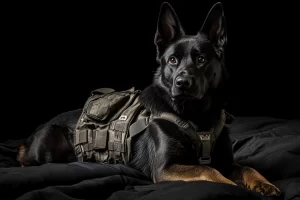Time to Read: 12-13 minutes
At Czech Working Line we often find ourselves traveling on an airline with our puppies. Below you will find ten helpful things to consider when preparing to to travel on an airline with your puppy. Traveling with a new puppy can be an exciting adventure but also requires thorough preparation to ensure the journey is smooth and stress-free. For those planning to travel by airline in the United States, understanding the rules and regulations is crucial. This comprehensive guide covers most everything you need to know about flying with a new puppy, from pre-flight preparations to post-flight care. We know that your search for that perfect German Shepherd for sale doesn’t end until you get your puppy back home. So here are some tips to help make this trip go smoothly.
1. Pre-Flight Preparations
Choosing the Right Airline
Different airlines have varying policies regarding pet travel. It’s essential to research and choose one that suits your needs and has a reputation for good pet care. Major airlines like Delta, American Airlines, United, and Southwest all offer pet travel options, but their specific rules, fees, and conditions can differ significantly.
Booking Your Flight
When booking your flight, inform the airline that you’ll be traveling with a puppy. Airlines often have a limit on the number of pets allowed per flight, so it’s advisable to book early. Some airlines might require you to make the reservation by phone to ensure all the necessary details are covered.
Health Requirements
Most airlines in the U.S. require a health certificate for your puppy, typically issued within ten days before travel. The exception to this rule can be when you fly your puppy domestically within the United States. American Airlines, for example, does not require a health certificate when you fly your own puppy with you in cabin. When you do need a certificate, your veterinarian will need to confirm that your puppy is healthy, up-to-date on vaccinations, and fit to fly. It’s also a good idea to bring any of your puppy’s medical records and vaccination certificates, as some airlines might request these upon check-in.
2. Airline-Specific Rules and Regulations
In-Cabin Travel
For young puppies, in-cabin travel is often the preferred method. Here are some standard rules:
Carrier Specifications: Airlines require that your puppy travels in an airline-approved carrier that fits under the seat in front of you. The carrier must be well-ventilated, secure, and large enough for the puppy to stand, turn around, and lie down comfortably.
Carrier Dimensions: Each airline has specific size requirements for carriers. For instance, American Airlines allows carriers up to 19 inches x 13 inches x 9 inches on most flights.
Pet Fee: Each airline charges a fee for in-cabin pets. Fees typically range from $75 to $200 per flight segment. It’s essential to check with your airline for their exact rate.
Age Restrictions: Most airlines have age restrictions on puppies. Typically, they must be at least 8 to 10 weeks old and weaned for travel. Some airlines may require puppies to be older.
Behavior Expectations: Airlines expect your puppy to behave well during the flight. They must remain in their carrier for the entire flight duration and should not bother other passengers.
Cargo Travel
For larger puppies or if in-cabin travel is not available, cargo travel is an option. Rules for cargo travel include:Temperature Guidelines: Airlines will not transport pets in the cargo hold if temperatures exceed a specific range, usually between 45°F and 85°F. This restriction is for the safety of the animals.
Kennel Requirements: Cargo kennels must be sturdy, ventilated on all sides, and large enough for your puppy to stand, turn, and lie down. They should also have a waterproof bottom.
Booking and Fees: Cargo travel is generally more expensive than in-cabin. Fees can range from $100 to over $500 depending on the airline and the size of your puppy.
Pre-Flight Arrival: For cargo travel, you’ll need to arrive at the airport earlier than for standard check-in, usually at least two hours before departure.
3. Preparing Your German Shepherd Puppy for Airline Travel
Acclimating Your Puppy to the Carrier
Start getting your puppy used to their carrier weeks before the flight. Place the carrier in an accessible area at home, and encourage your puppy to enter it by placing treats and toys inside. Gradually increase the amount of time they spend inside to prevent anxiety during the flight.
Feeding and Hydration
Feed your puppy a light meal a few hours before the flight to prevent an upset stomach. Hydrate them well, but avoid too much water right before the trip. You can use ice chips, which provide hydration without excessive amounts of water.
Exercise
Exercise your puppy before heading to the airport to help expend their energy. A tired puppy is more likely to sleep through the flight, making the experience less stressful for both of you.
4. At the Airport
Check-In
Having searched for a German Shepherd for sale— and found that perfect match. Now, you have to get home. Arrive early to allow ample time for the check-in process, especially if your puppy is traveling in the cargo hold. Present the required documents, such as the health certificate, and ensure the carrier meets the airline’s specifications.
Security Screening
For in-cabin travel, you’ll need to take your puppy out of the carrier as you pass through security. The carrier will go through the x-ray machine, while you carry your puppy through the metal detector. Make sure your puppy is leashed or harnessed to prevent them from running off.
5. During the Flight
Keeping Your Puppy Comfortable
Once on the plane, place the carrier under the seat in front of you. Refrain from taking your puppy out of the carrier during the flight, as airlines generally prohibit this. Speak soothingly to your puppy and offer them a chew toy or something familiar for comfort.
Managing Anxiety
Some puppies may experience anxiety during flights. Consider using a pheromone spray designed for travel or consult your veterinarian about anti-anxiety medications. Always test any new treatments before the day of the flight to ensure they don’t cause adverse reactions.
6. After the Flight
Picking Up Your Puppy
If your puppy traveled in the cargo hold, head to the cargo pickup area immediately after landing. Dogs are usually released before luggage, but the sooner you get there, the sooner you can reunite and comfort your puppy.
Post-Flight Care\
Offer water and a light meal once you’ve arrived at your destination. Ensure your puppy gets ample time to stretch and relieve themselves. Check for any signs of stress or discomfort, and consult a veterinarian if you notice anything concerning.
7. International Travel Considerations
For international travel, additional regulations and documentation will be required. This process often involves:
Import Permits: Some countries require an import permit for pets.
Health and Vaccination Records: Comprehensive records, including vaccinations and rabies shots, are commonly required.
Quarantine: Certain destinations mandate a quarantine period for pets, especially if they are traveling from a country with different endemic diseases.
Microchipping: Many countries require your pet to be microchipped with an ISO-compliant chip.
Preparing for international travel can be a lengthy process, so start planning months in advance.
8. Airline Pet Policies: A Quick Overview
American Airlines
In-Cabin: Pets are allowed on most flights but typically only one pet carrier per passenger. There are additional fees, usually around $125 per kennel within the United States.
Cargo: Pets traveling as cargo must be booked through the airline’s cargo service, and rates can vary.
Delta Airlines- In-Cabin: Delta allows small dogs, cats, and household birds in the cabin on most flights within the United States for a fee of $125. Delta Cargo: For pets traveling as cargo, Delta offers a Pet First service, ensuring climate-controlled cargo holds and safe handling.
United Airlines- In-Cabin: United allows pets to travel in the cabin on most flights with a fee of $125 per pet. United Airlines Cargo: United has a robust PetSafe program for pets traveling in the cargo hold, ensuring temperature-controlled environments and special handling.
Southwest Airlines- In-Cabin Only: Southwest only allows small pets to travel in the cabin, subject to a $95 fee each way. Southwest does not allow pets to travel as cargo.
9. Legal and Regulatory Considerations
Federal Regulations
The United States Department of Agriculture (USDA) governs the transportation of pets under the Animal Welfare Act. The USDA’s regulations establish standards for the care and treatment of animals transported via common carriers. Airlines must comply with these standards, including requirements for animal enclosures, temperature control, and handling.
State Regulations
Some states have additional regulations or requirements for pet travel. For instance, Hawaii, a rabies-free state, has strict quarantine laws for pets arriving from outside the state to maintain its rabies-free status. Always check state-specific regulations well in advance of travel.
10. Tips for a Stress-Free Journey as you fly home with your German Shepherd puppy
Arrival Early at the Airport
Arriving early helps minimize stress and ensures enough time to pass through check-in and security. If possible, take a direct flight to reduce the overall travel time and avoid the challenges of layovers.
Communication with Airline Staff
Communicate your needs and concerns with airline staff. They are often more than willing to ensure the safety and comfort of your puppy. Provide any necessary contact information and follow-up instructions if your pet is traveling in the cargo hold.
Ensure the Breeder Prepares Your Puppy to Travel in a Vehicle
If possible, take your puppy on short car trips with the carrier leading up to your flight. This helps them get accustomed to traveling in the carrier and reduces anxiety about unfamiliar experiences.
Crate Training
Crate training can be extremely beneficial when preparing for air travel. If your puppy views the crate as a safe space, they will likely be more comfortable and less anxious during the flight. Gradually acclimate your puppy to spending time in the crate, offering treats and praise to create a positive association.
Choosing the Right Flight Time
Try to book flights during cooler parts of the day, especially if traveling in warmer months. Early morning or late evening flights are often more comfortable for pets and are less busy, reducing stress levels.
Hydration and Potty Breaks
Ensuring your puppy stays hydrated is crucial, but be mindful of their potty needs. Offer small amounts of water leading up to the flight and keep potty pads handy, especially for longer journeys.
Conclusion
Many of our customers will have found us as a result of searching for a German Shepherd for sale. Rest assured that at https://czechworkingline.com we go the extra mile in preparing our puppies for traveling. We do so by introducing them to riding in a vehicle, and early crate training. We know that most all of you are wanting to find the best German Shepherd puppies for sale. You truly do want something great. Something that will be healthy. That will be easy to train. a good temperament and respond well to new situations. When you do finally find that puppy, you have to get him home. For many of you, this can involve flying to come pick up your puppy. Traveling with a new puppy on an airline in the United States involves careful planning and adherence to various regulations. However, knowing the rules and preparing in advance can ensure a smooth journey for both you and your furry companion. By choosing the right airline, understanding health and carrier requirements, acclimating your puppy to travel, and following post-flight care tips, you can make the experience enjoyable and safe.
With thorough preparation, your puppy can travel comfortably, and you can focus on enjoying your time together at your destination. Always remember that patience, planning, and understanding your puppy’s needs are key to a successful journey. Safe travels!




